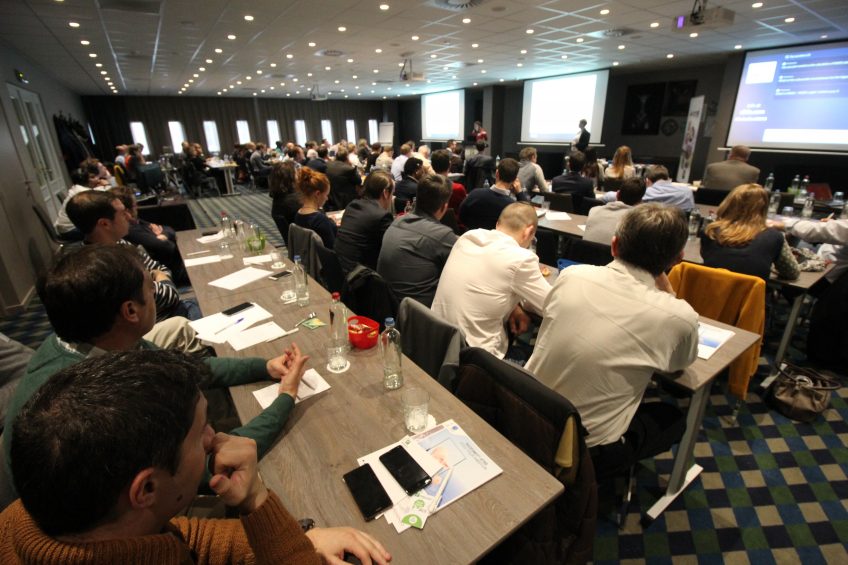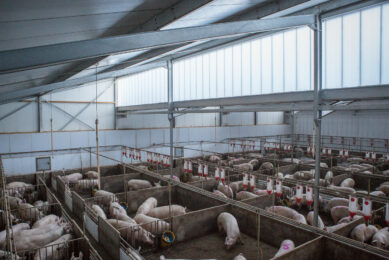Methionine in the spotlight at Adisseo pig event

Adisseo zoomed in on the effect of methionine and selenium in sows, piglets and pork at a 2-day event in Brussels, Belgium. Also considerable attention was given to pig production in Denmark.
The venue in Brussels was visited by about 75 experts from various countries across Europe on March 6 and 7.
Overview of production in Denmark
Opening speaker at the event was Christian Fink Hansen, director of research institute SEGES in Denmark. He gave an introduction of the situation of pig production in Denmark, having 3,300 swine producers (going down) and about 1 million sows (staying stable). Production is nevertheless on the rise, he said, with Denmark producing the most weaned piglets per sow per year.
He touched on various trends, e.g. antibiotics usage having gone down in recent years – and how the Danish ‘yellow card’ system helped to achieve that. Also the problem of zinc oxide was touched on.

In addition, Dr Fink Hansen spoke of the new 3-level welfare system that was introduced to promote pork that was produced in an animal friendly way. Interestingly, he also produced a slide highlighting why consumers would not buy food promoting high levels of welfare. ‘Expensive’ and ‘confusing labelling’ were 2 of the most quoted reasons in this respect.
2-component feeding
Next, Peter Kappel Theil, senior scientist at Aarhus University, Denmark, zoomed in on sow nutrition in relation to piglet survival and liveability. Interesting in his presentation was the introduction of the concept ‘2-component feeding’ for lactating sows.
Key to this thought is the idea that sows need energy for maintenance purposes on one hand, but also a combination of lysine and energy for milk production on the other. When taking that philosophy into account, Dr Kappel Theil said, the feed supply will get much closer to the animal’s needs during the lactation phase, resulting in a minimisation of weight loss as well as a more efficient restoration of body condition after weaning.
He had several comments on the farrowing process, e.g. that fibrous feed for sows can be beneficial before parturition and that fat sows usually have extended farrowing length. In addition, Dr Kappel Theil said, both fibre and fat sources in sow diets are important for creating colostrum quality.
Robustness of piglets at weaning
‘Robustness of piglets at weaning’ was the key theme of the presentation of researcher Elodie Merlot of the French National Institute for Agricultural Research (INRA). In order to say something about ‘robustness’, she searched for a definition and related it to 3 components, being:
• Production (preserved growth);
• Health (no diarrhoea or other clinical disturbances);
• Welfare (reduced stress response).
The quest to define biological variables of ‘robustness’ proved to be a complex one. She admitted that it is not a concept that is simple to apply in real life. In the blood Dr Merlot and her team identified various types of variables that look promising, e.g. metabolic, oxidative status and immune variables.
Effects of sow diets for piglets
Speakers Mickaël Briens and Dolores Batonon-Alavo, both researchers at Adisseo, had 2 sessions where they presented their updates in pig research. In the 1st, they zoomed in on the effects sows can pass on to their piglets and focused on Adisseo’s flagship products for pigs, revolving around methionine and selenium.

Seleno-methionine, an organic form of selenium, to sows, can be transferred to piglets through maternial diets, the researchers stated. This product was observed to improve some antioxidant biomarkers and immune parameters.
In addition, the researchers spoke of hydroxy-methionine (HMTBA) – when supplied to sows can improve the performance of piglet and sow body conditions. Supplying of HMTBA above requirements was observed to enhance the piglets’ ability to improve growth performance.
Pig of tomorrow
The 2nd day of the event started with a presentation by Patrick Chevillon of the French Pork and Pig Institute (IFIP) on the ‘pig of tomorrow’. He mainlylooked at the expectations of processors and consumers, pig meat quality levels, links between breeding and quality and how to integrate animal welfare in that picture.
He delved into questions on how to influence intramuscular fat levels, e.g. by a more specific nutrition programme and also by including more Duroc genetics in the breeding line.
With regard to welfare, he touched briefly on schemes like ‘Beter Leven’ in the Netherlands and ‘Aktion Tierwohl’ in Germany, which provide for minimum welfare circumstances for pigs to live in.
Effects of methionine and selenium on meat quality
Researchers Dolores Batonon-Alavo and Mickaël Briens also shared some of the latest results of methionine and selenium as leverages to improve meat quality in swine. The researchers stated that oxidative stresses are present all along the value chain of animal production.
Feeding both methionine as well as selenium can help to reduce drip loss, improve the technological quality of pork and also improve meat tenderness.
Electrolyte balance
The dietary electrolyte balance (dEB) was the key theme of the last presentation, by well-known pig researcher Dr Nathalie Quiniou, also associated with the French Pork and Pig Institute (IFIP). The dEB is an indication of the metabolisable ions which could generate or consume acid during metabolism.

During her presentation it became very clear that the dEB in diets plays a role in many functions of pigs, of all types. Summing up results from many different researchers, she said that for grow-finishers, the dEB can e.g. influence carcass leanness, nutrient digestibility and stomach health. In sows, there is a relationship between dEB levels in diets with for instance survival rate and pig vitality at birth.











